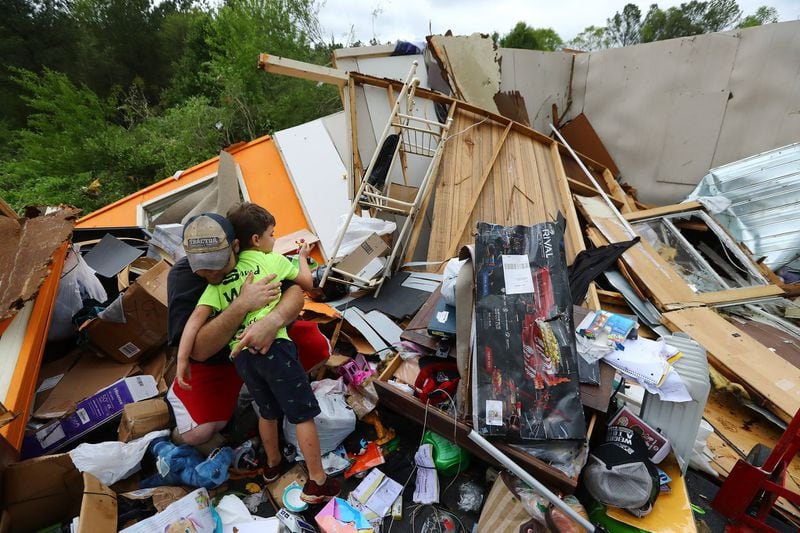2020 was a year unlike any other in U.S. history. Before we embark on 2021 and the promise that it brings, The Atlanta Journal-Constitution’s content curation desk is taking a look back at the most impactful stories of 2020 and their effects on Georgia and the rest of the nation. Today’s topic: Weather
5. Wildfires bring hell on Earth
California experienced one of its worst years for wildfires in 2020.
Flames reportedly scorched swaths of land in the West larger than the combined area of Connecticut, Rhode Island and Delaware, according to numerous sources.
The wildfires have lasted well into December, with the most recent forcing residents in Orange County’s Silverado Canyon to flee their homes Dec. 4.
Since the summer, at least 31 people have been killed and 10,500 homes and other structures damaged or destroyed in fires. In November, more than 1,000 people in Reno, Nevada, were forced to evacuate when a wind-whipped wildfire roared through a neighborhood.
Familiar scenes played out for months in 2020 across several states.
One of the more massive blazes began after a “smoke-generating pyrotechnic device” was used at a gender reveal party, which ignited the El Dorado wildfire that consumed tens of thousands of acres east of Los Angeles over Labor Day weekend, authorities said.
In other cases, fires were ignited by arson, lightning strikes, faulty power lines or malfunctioning power company equipment.
Amid a summer of record heat and dry winds, the flames turned the landscape across the West into a virtual hell on Earth.
Firefighters raced for weeks to contain one spiraling fire after another, straining their emergency services and prompting them to plead for help from other states and the federal government, The New York Times reported.
In September, authorities in southern Oregon charged a 41-year-old man with starting part of one of the year’s most destructive fires, saying he lit a fire in Ashland as a larger blaze moved toward the area, according to The New York Times.
About 87 large wildfires were burning simultaneously across the United States in Idaho, Oregon and Nevada during September, with the most being in California, according to CNN.
Millions upon millions of acres have burned all year.
Throughout California, blazes were named after the areas they burned, including the Silverado fire, the Bond fire, the Blue Ridge fire and the Glass fire in St. Helena.
Notably in the Castle fire, flames burned through portions of roughly 20 giant sequoia groves on the western slopes of the Sierra, the only place on the planet they naturally grow. The San Bernardino National Forest was also hard hit.
Numerous studies have linked bigger wildfires in America to climate change from the burning of coal, oil and gas. Scientists have said climate change has made California much drier, meaning trees and other plants are more flammable.
4. Giant dust plume floats to Georgia
As if Atlanta’s air wasn’t bad enough!
In June, a massive and slow-moving plume of dust floated to the Southern U.S. from Africa’s Sahara Desert and settled in, you guessed it, the skies above metro Atlanta.
Despite a week’s worth of picturesque sunsets and spectacular sunrises, the dusty air also delivered a few concerns for residents with respiratory issues.
A strong westward wind current had blown the cloud — a mix of dust and sand — across the Atlantic Ocean, Caribbean and Gulf of Mexico right at the start of summer.
The dirt cloud whirled above the Earth’s surface at about 20,000 feet, according to the NOAA Hurricane Research Division.
Dust clouds are common during that time of year, but the one that drifted into Atlanta in 2020 was far notable for its size and thickness, according to accounts. The media dubbed the natural phenomenon the Godzilla dust cloud — the largest in a long time.
3. Tornadoes kill 8 in Georgia
At least 15 tornadoes touched down in Georgia in April, leaving eight people dead.
The powerful storms, already blamed for dozens of deaths across the Southeast, barged into Georgia on April 12 and ravaged Georgia from late Sunday into early Monday. In addition to the eight dead, 49 more were injured. In metro Atlanta, trees landed on homes and cars and across roads. North Georgia was hit much harder. A total of 23 homes were destroyed, 59 other homes had minor damage and another 248 homes had to be assessed for their structural safety. In the immediate aftermath, 177,000 Georgians were without electricity, including many in North Georgia.
The most powerful twister reportedly hit Upson County, the National Weather Service said. That’s where a home was reportedly lifted from its foundation and blown more than 50 yards, landing in the middle of a road.
Seven of those who died lived in Murray County, where investigators believe an EF-2 tornado hit a mobile home community. The eighth person was killed in Bartow County by an EF-1 tornado, according to the NWS.
In Bartow County, where an EF-1 tornado with winds up to 90 mph swept through the area, 34-year-old William McConnell was killed when a tree fell on his house on Fite Street, according to Coroner Joel Guyton.
2. Tornadoes kill 22 in Tennessee
At least 22 people were killed, several of them children, after a series of tornadoes ripped across Tennessee on March 3. The fatalities were spread across four counties, according to a report from the Tennessee Department of Health. There were 16 deaths in Putnam County, which is in Middle Tennessee, two deaths in Nashville’s Davidson County, three in Wilson County, which is in metro Nashville; and one person died in Benton County.
One of the violent tornadoes that rolled through Putnam County a day earlier reportedly claimed the lives of several children.
Police officers and fire crews responded to about 40 building collapses around the city, Metro Nashville police said. Daybreak revealed the dangers of a landscape littered with blown-down walls and roofs, snapped power lines and huge broken trees.
1. An unprecedented hurricane season
A record-setting Atlantic hurricane season brought with it the highest number of named storms in history.
The National Oceanic and Atmospheric Administration said 2020 set multiple records while producing a whopping 30 named storms.
For only the second time, the Greek alphabet had to be used to name storms because the record number of cyclones had exhausted the list of 21 conventional names.
The season also saw the second-highest number of hurricanes on record after 13 of the storms reached hurricane status. There were six major hurricanes with top winds of 111 mph or greater. NOAA said an average season has 12 named storms, six hurricanes and three major hurricanes.
This season also set a record for the number of storms that made landfall in the continental U.S. with 12 such storms. Of those 12 named storms, six made landfall at hurricane strength, tying the record set in 1886 and 1985.
Two of the powerful Atlantic storms blew through Georgia and left havoc in their wake.
The remnants of Hurricane Sally, a slow-moving storm, left two dead as it flooded streets, flattened trees and knocked out power to thousands of Georgians in mid-September. The relentless storm also left behind a soggy, treacherous mess that shut down bridges and tangled traffic for miles on the interstates.
In late October, Tropical Storm Zeta, the 27th named storm and sixth hurricane to make landfall in the United States, swept through North Georgia, leaving at least three people dead in metro Atlanta and nearly 1 million in the dark.
Zeta first made landfall as a Category 2 hurricane, lashing the Louisiana coast with 110 mph winds. It weakened to a tropical storm by the time it reached Georgia, with winds gusting at 51 mph in Atlanta and 55 mph in Rome. The worst of the storm tore through the region between 4 a.m. and 7 a.m.
Other stories in the series
About the Author







